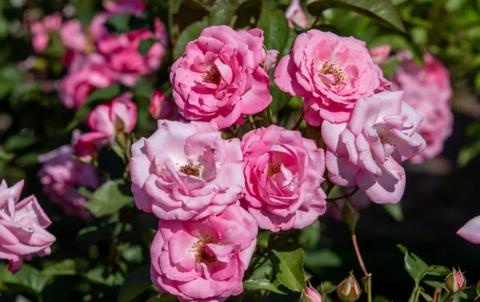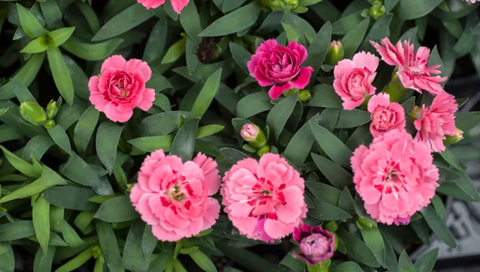Have you ever admired the vibrant hues of bougainvillea cascading over a garden wall and wondered how to cultivate such beauty in your own yard? In this comprehensive guide, we'll delve into the intricacies of growing and caring for bougainvillea plants, providing you with all the essential knowledge to ensure their successful growth and blooming splendor.The following content also has some reference value for raised garden beds.
Understanding Bougainvillea
Botanical background and origins
Bougainvillea, named after French explorer Louis Antoine de Bougainville, is native to South America, particularly Brazil, Peru, and Argentina. Belonging to the Nyctaginaceae family, this flowering plant is renowned for its vibrant bracts, which come in an array of colors, including pink, red, purple, and orange.
Growth habits and characteristics
Characterized by vigorous growth and thorny branches, bougainvillea exhibits a sprawling habit, making it ideal for covering fences, walls, and arbors. Its drought tolerance and ability to thrive in warm climates have contributed to its popularity in Mediterranean and tropical regions worldwide.
Choosing the Right Bougainvillea Variety
Varieties suited to different climates
Selecting the appropriate bougainvillea variety for your climate is crucial for ensuring optimal growth and blooming. Varieties like 'Barbara Karst' and 'Raspberry Ice' thrive in warmer climates, while 'California Gold' and 'James Walker' are better suited to cooler regions.
Considerations for color preferences
With a plethora of color options available, consider your color preferences and landscaping aesthetics when choosing a bougainvillea variety. Whether you prefer vibrant pinks, fiery oranges, or regal purples, there's a bougainvillea hue to complement any garden palette.
Selecting the Ideal Location
Sunlight requirements
Bougainvillea thrives in full sun, requiring a minimum of 6 to 8 hours of direct sunlight daily to promote robust growth and abundant flowering. Choose a location with ample sunlight exposure, such as a south-facing wall or open courtyard.

Soil preferences and drainage
Well-draining soil is essential for bougainvillea cultivation, as these plants are susceptible to root rot in waterlogged conditions. Opt for sandy or loamy soil with good drainage to prevent water accumulation and ensure healthy root development.
Planting Bougainvillea
Best times for planting
Spring and early summer are the ideal times for planting bougainvillea, allowing the plants to establish their root systems before the onset of winter or extreme heat. Avoid planting during periods of frost or intense heat to minimize transplant shock.
Proper planting techniques
When planting bougainvillea, dig a hole twice as wide as the root ball and incorporate organic matter, such as compost or aged manure, into the soil. Position the plant at the same depth as it was in the nursery container and backfill the hole, gently firming the soil around the roots.
Watering Bougainvillea
Watering frequency and amount
While bougainvillea is drought-tolerant once established, adequate watering is essential during the initial establishment period. Water deeply but infrequently, allowing the soil to dry out between waterings to encourage deep root growth.
Tips for avoiding overwatering
To prevent overwatering, monitor soil moisture levels regularly and adjust your watering schedule accordingly. Avoid watering bougainvillea plants from overhead, as wet foliage can promote fungal diseases. Instead, water it at the base of the plant to deliver moisture directly to the roots.
Fertilizing Bougainvillea
Nutritional needs
Bougainvillea plants have moderate nutritional requirements, benefiting from regular applications of balanced fertilizer during the growing season. Look for a fertilizer with a balanced NPK ratio, such as 10-10-10 or 20-20-20, to provide essential nutrients for healthy growth and flowering.
Types of fertilizers and application methods
Granular or water-soluble fertilizers are suitable for feeding bougainvillea plants. Apply fertilizer according to package instructions, distributing it evenly around the root zone and watering thoroughly afterward to promote nutrient uptake.

Pruning and Training
Importance of pruning for shape and size control
Pruning is essential for maintaining the desired shape and size of bougainvillea plants, as well as promoting flowering. Regular pruning encourages branching and removes dead or damaged growth, resulting in a more compact and prolific plant.
Techniques for training bougainvillea on trellises or arbors
Training bougainvillea on trellises or arbors enhances their ornamental value and creates stunning vertical accents in the garden. Use soft ties or twine to secure the branches to the support structure, guiding them upward and outward for optimal coverage and visual impact.
Managing Pests and Diseases
Common pests affecting bougainvillea
Bougainvillea plants are relatively pest-resistant but may occasionally be plagued by aphids, mealybugs, or spider mites. Monitor plants regularly for signs of pest infestation, such as distorted growth or sticky honeydew, and treat promptly with insecticidal soap or horticultural oil.
Strategies for preventing and treating diseases
Diseases such as powdery mildew and bacterial leaf spot can affect bougainvillea plants, particularly in humid or poorly ventilated conditions. Practice good sanitation by removing fallen leaves and debris, and apply fungicides preventively to minimize the risk of disease outbreaks.
Supporting Bougainvillea in Containers
Choosing the right container size and type
When growing bougainvillea in containers, select a large, sturdy pot with adequate drainage holes to accommodate the plant's root system and prevent waterlogging. Terra cotta or resin containers are excellent choices, providing stability and allowing for proper aeration of the roots.
Tips for container gardening success
Ensure proper drainage by layering the bottom of the container with gravel or broken pottery shards before adding potting soil. Use a well-draining potting mix formulated for container plants and water regularly to prevent drought stress in confined growing spaces.
Overwintering Bougainvillea
Cold protection measures
In regions with frost or freezing temperatures, provide cold protection for bougainvillea plants by covering them with frost cloth or moving them to a sheltered location, such as a greenhouse or garage. Mulching around the base of the plant can also help insulate the roots from cold damage.

Indoor care during winter months
For bougainvillea grown in containers, bring them indoors before the first frost and place them in a bright, sunny location away from drafts. Reduce watering frequency during the winter months to prevent waterlogged soil and maintain moderate humidity levels to prevent drying out.
Conclusion
In conclusion, cultivating bougainvillea plants can be a rewarding endeavor, offering a profusion of colorful blooms and lush foliage to enhance your outdoor living space. By understanding the botanical background, selecting the right variety, and providing proper care and maintenance, even novice gardeners can enjoy the beauty and resilience of bougainvillea in their own gardens.









